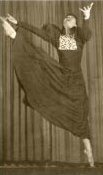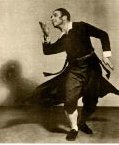People familiar with Leo Rosten’s Joys of Yiddish will recognize this illustration of the ways that Yiddish’s emphasis on tone and inflection to express meaning has influenced English:
Even the English question “I should buy two tickets for her concert?” can take on seven meanings depending on where the emphasis is placed — a common thing among Yiddish speakers:
– I should buy two tickets for her concert? — “After what she did to me? And nu, her mother should return some of my calls now and then?”
– I should buy two tickets for her concert? — “What, you’re giving me a lesson in ethics? And who are you that you should think you know?”
– I should buy two tickets for her concert? — “I wouldn’t go even if she was giving out free passes — or if she paid me!”
– I should buy two tickets for her concert? — “I’m having enough trouble deciding if it’s even worth one – and you barely even call since your father died, nu, all the sudden you have time to see a concert with me?”
– I should buy two tickets for her concert? — “She should be giving out free passes, or the hall will be empty, what with that tone-deaf mother of hers, she can be no better.”
– I should buy two tickets for her concert? — “Did she buy tickets at our daughter’s recital? What, all the sudden she expects me to do for her? Hrmph!”
– I should buy two tickets for her concert? — “You mean, they call what she does a ‘concert’? This is an art form?”
The exercise falls prey to a few different stereotypes, but it’s fun nonetheless.
Also, I should have posted this days ago, but Laila El-Haddad has posted ways that you can help Gaza. Here’s a heavily abridged version so you can get the gist (visit her blog for a wealth of links):
1. Get informed. Sounds easy enough, but a large number of people I have met whose gut instinct is to sympathize with the Palestinians cause are surprisingly uninformed about the issue, or the history. Ipsa Scientia Potestas Est. And oh so true. Being informed will enable you to speak intelligently about the topic-whether to your family, to your friends, to your co-workers, or to your politicians….
2. Wear a Palestine pin, t-shirt, or arm-band-great conversation starters and ways to show your support. You can purchase a number of creative shirts online in the Palestine online store or Cafe Press.
3. Contact local media. Write letters to editors (usually 100-150 words) and longer op-eds (usually 600-800 words) for local newspapers. But also write to news departments in both print, audio, and visual media about their coverage. In the US http://tinyurl.com/2jxwf You can find media listings in your country using search engines like google.
4. BDS!! Boycott, Divestment, and Sanctions. Now more than ever the BDS campaign must be used and intensified against Israel to end its impunity and to hold it accountable for its persistent violation of international law and Palestinian rights. Remember: It was only when Apartheid was abnormalized that the anti-Apartheid movement gained momentum.
Thus, our efforts must focus on abnormalizing Israel’s illegal occupation and its tactics. Begin work to encourage your local institutions to divest from Israel….
5. Contact elected and other political leaders in your country to urge them to apply pressure to end the attacks. In the US, Contact the State Department at 202.647.5291, the White House 202-456-1111 the Egyptian Embassy 202.895.5400,
6. Work towards bringing Israeli leaders before war crime courts (actions along those lines in courts have stopped Israeli leaders from traveling abroad to some countries like Britain where they may face charges).
7. Join local groups in your area active on the issue. Many-such as those here in Durham- have also been successful in at bringing coalitions from different constituencies in their local areas to work together (human rights group, social and civil activists, religious activists, etc) and most are made of ordinary people who also have other lives to live and so welcome any input and activism….
8. Visit Palestine! Two great groups that facilitate such trips are the Alternative Tourism Group, whose guide I helped write, and the Siraj Center.
If you cannot visit, support human rights and other groups working on the ground in Palestine, such as the Free Gaza Movement (which accepts tax-exempt donations).
9. Contact your local churches, mosques, synagogues, and other houses of worship or institutions and ask them to take a moral stand and act.
10. Support Palestinian farmers and workers by buying gifts and produce directly from the West Bank and Gaza…..
11. If you prefer, donate your money to a charity, or hold a creative bake sale (manaeesh anyone?)…..
I’ve written before about my feelings on Israel-wide boycotts (as opposed to, I should point out, occupied West Bank boycotts), but I think “abnormalizing” the occupation is spot-on. Bandwagons are unfortunately all too popular, and as long as the bandwagon supports Israel unconditionally, we’re not going to see any improvement. If criticism of Israel become more mainstream, however, I think it would increase exponentially as people either realized that it’s “okay” to deviate from accepted narratives or just went along with what people around them thought. (This does, of course, open up the floodgates for anti-Semitism, but that’s a whole different problem.)
By the way, like my shiny new button in the right sidebar there? Click it and sign JVP’s letter to Obama! They have the design on T shirts, too!
Filed under: Israel, Palestine, Yiddish | Leave a comment »


 A few weeks ago I attended
A few weeks ago I attended  Of course, Zemach himself – along with the other actors and dancers whose performances I watched at the forum – focused on Old World themes, as evidenced by the costumes in the two photos. The irony of this isn’t lost on me. Is 20th and 21st century Yiddish identity ultimately recursive? Are we destined to circle back to the same modes of Jewish expression over and over again? Was all hope of a kinetic and evolving secular Yiddish identity lost with the rise of Zionism? And do other cultures share this problem? Federations and synagogues constantly complain about the lack of interest among young adults in Jewish identity – but sometimes it feels like Jewish identity doesn’t give us any room to stretch, to question, to move. We go on Birthright, we learn Hebrew, we study the Holocaust, we sing about the shtetls. But the identity that’s painted on our faces and bodies always seems to be expressed in someone else’s terms.
Of course, Zemach himself – along with the other actors and dancers whose performances I watched at the forum – focused on Old World themes, as evidenced by the costumes in the two photos. The irony of this isn’t lost on me. Is 20th and 21st century Yiddish identity ultimately recursive? Are we destined to circle back to the same modes of Jewish expression over and over again? Was all hope of a kinetic and evolving secular Yiddish identity lost with the rise of Zionism? And do other cultures share this problem? Federations and synagogues constantly complain about the lack of interest among young adults in Jewish identity – but sometimes it feels like Jewish identity doesn’t give us any room to stretch, to question, to move. We go on Birthright, we learn Hebrew, we study the Holocaust, we sing about the shtetls. But the identity that’s painted on our faces and bodies always seems to be expressed in someone else’s terms.
